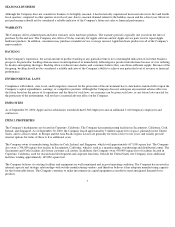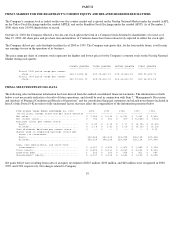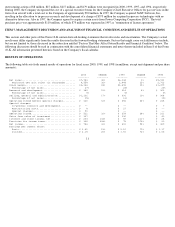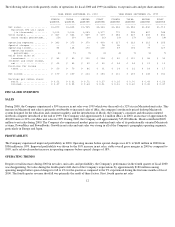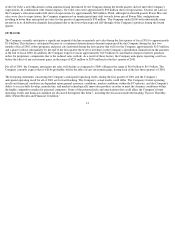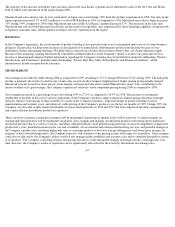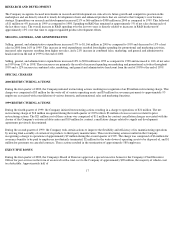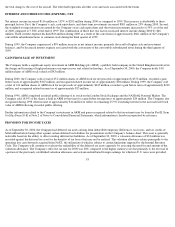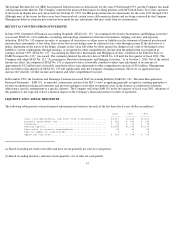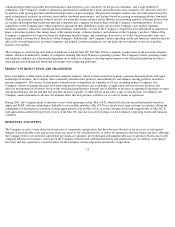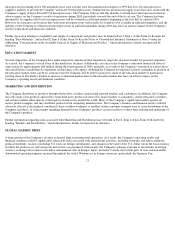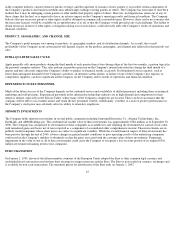Apple 2000 Annual Report Download - page 19
Download and view the complete annual report
Please find page 19 of the 2000 Apple annual report below. You can navigate through the pages in the report by either clicking on the pages listed below, or by using the keyword search tool below to find specific information within the annual report.The majority of the increase in both net sales and unit sales in the Asia Pacific segment can be attributed to sales of the G4 Cube and iBook,
both of which were introduced in the region during 2000.
Macintosh unit sales and net sales in Asia, particularly in Japan, recovered during 1999 from the declines experienced in 1998. Net sales in the
Japan segment increased 17% or $127 million to a total of $858 million in 1999 as compared to 1998. Macintosh unit sales in Japan increased
35% during 1999 compared to 1998 while Macintosh unit sales in the Asia Pacific segment increased 37%. The increases in net sales and
Macintosh unit sales in both Japan and Asia Pacific are the result of strong iMac sales experienced by these operating segments, strong growth
in Japanese consumer sales, and the general economic recovery experienced in the region.
BACKLOG
In the Company's experience, the actual amount of product backlog at any particular time is not a meaningful indication of its future business
prospects. In particular, backlog often increases in anticipation of or immediately following new product introductions because of over-
ordering by dealers anticipating shortages. Backlog often is reduced once dealers and customers believe they can obtain sufficient supply.
Because of the foregoing, backlog should not be considered a reliable indicator of the Company's ability to achieve any particular level of
revenue or financial performance. Further information regarding the Company's backlog may be found below under the subheading "Product
Introductions and Transitions" included under the heading "Factors That May Affect Future Results and Financial Condition," which
information is hereby incorporated by reference.
GROSS MARGIN
Gross margin was relatively stable during 2000 as compared to 1999, declining to 27.1% during 2000 from 27.6% during 1999. The half point
decline is primarily the result of a shift in mix of unit sales away from the Company's higher priced, higher margin professionally oriented
Macintosh systems towards its lower priced, lower margin consumer and education oriented Macintosh systems. Also contributing to the
relative stability of its gross margin, the Company experienced relatively stable component pricing during 2000 as compared to 1999.
Gross margin increased as a percentage of net sales during 1999 to 27.6% as compared to 24.9% in 1998. This increase was primarily
attributable to declines in the cost of various components of the Company's products, improvements in manufacturing efficiencies brought
about by selective outsourcing of final assembly of certain of the Company's products, improved design of products leading to lower
manufacturing and warranty costs, and relatively stable pricing of the Company's products over the last six months of 1999. During 1999, the
Company was also able to fully realize the benefits of actions taken primarily in 1998 and 1997 that led to improved inventory management
and a more efficient distribution model for its products.
There can be no assurance current gross margins will be maintained, targeted gross margin levels will be achieved, or current margins on
existing individual products will be maintained. In general, gross margins and margins on individual products will remain under significant
downward pressure due to a variety of factors, including continued industry wide global pricing pressures, increased competition, compressed
product life cycles, potential increases in the cost and availability of raw material and outside manufacturing services, and potential changes to
the Company's product mix, including higher unit sales of consumer products with lower average selling prices and lower gross margins. In
response to these downward pressures, the Company expects it will continue to take pricing actions with respect to its products. Gross margins
could also be affected by the Company's ability to effectively manage quality problems and warranty costs and to stimulate demand for certain
of its products. The Company's operating strategy and pricing take into account anticipated changes in foreign currency exchange rates over
time; however, the Company's results of operations can be significantly affected in the short term by fluctuations in exchange rates.
16



